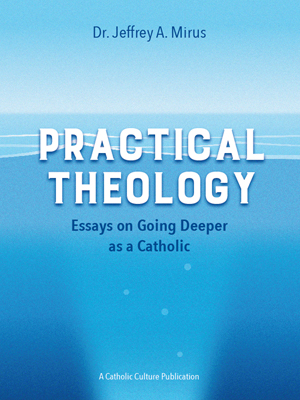God's Love Overflows
Dec. 27,1673, was an ordinary day for Visitation Sister Margaret Mary Alacoque until Jesus appeared to her.
Not that seeing Christ in a vision was unusual for the 26-year-old French nun. That had been happening since she was 20.
On that day, as was her custom, Sister Margaret Mary was praying before the Blessed Sacrament in her convent chapel. As she did, Our Lord appeared and called her "the beloved disciple of the Sacred Heart." Then she watched as Jesus took her heart, joined it to His own, and then placed it back in her body.
After that, on each first Friday of the month, Sister Margaret Mary — now St. Margaret Mary (1647-1690, feast day Oct. 16) — experienced pain in her side where Jesus had "removed her heart to be joined with His." And over the next year and a half, her other revelations about the Sacred Heart were received on first Fridays.
During one of her visions, Jesus showed himself as a heart surrounded by a crown of thorns with a cross above it. That was how the bleeding heart became the symbol of Christ's burning love for humanity.
During another private revelation, the French nun was told to receive the Eucharist as frequently as her vow of obedience would allow, but especially on first Fridays. The Lord also asked her to spend one hour each week in prayer before the Blessed Sacrament.
And in a final vision, Jesus asked that the first Friday after the octave of the feast of Corpus Christi be dedicated in honor of the Sacred Heart.
But while it was St. Margaret Mary who played the central role in popularizing this devotion, it was a contemporary of hers, Father John Eudes — now St. John Eudes (1601-1680, feast day Aug. 19) — who was its champion.
In his writing, the French priest had outlined the importance that must be placed on devotion to Jesus' Sacred Heart. He had explained that humanity has a need to praise, bless, glorify and thank Christ for His love, to ask pardon for offenses against His great love, and to make reparation for such sins.
St. John had also spoken of the need to demonstrate love to Christ in return for all His love, and to beg the Lord to establish within human hearts the reign of His love. For St. John, the Sacred Heart of Jesus combined "three loves": the divine uncreated love of Christ, the human love of Jesus proceeding through His human will, and the sensible and emotional love of Jesus symbolized by the heart of flesh.
To designate this unity, St. John distinguished three hearts in Jesus: divine, spiritual and physical. The priest understood the divine heart to be the soul, the life and the heart of both the spiritual and physical hearts.
The cleric was also significant in the development of devotion to the Sacred Heart in its liturgical celebration. Although historical accounts differ as to dates, in about 1672 St. John received permission to celebrate a divine office and Mass in honor of the Sacred Heart. The prayers of both the office and Mass, however, referred more to the Immaculate Heart of Mary than to the Sacred Heart of Jesus.
Devotion to the Sacred Heart had been around since the Middle Ages and had been developed by a number of mystics, including St. Bernard of Clairvaux (1090-1153) and St. Catherine of Sienna (1347-1380). It was St. Francis de Sales (1567-1622) who stressed its importance to the Visitandines — the Visitation Sisters — and to St. John Eudes. But it wasn't until St. John defined the devotion theologically and St. Margaret Mary "saw" the Sacred Heart, that it became widely popular.
The roots of that popularity — which continues today — can be traced to one of the first steps St. Margaret Mary took after her visions began. She soon talked about them to Mother Saumaise, superior of the convent, who suggested she share them with others better versed in such matters. And so St. Margaret Mary told her spiritual director, Father (now Blessed) Claude de La Colombiere, what had happened. Blessed Claude — and his fellow Jesuits — immediately began promoting devotion to the Sacred Heart.
Public devotion was introduced by the French bishop, Charles Francois de Lomenie. He consecrated a chapel in honor of the Sacred Heart in his seminary in 1688 and erected a confraternity — an association — under the same title. Other dioceses in France helped spread the devotion by adopting the feast.
Official approval from Rome for the feast of the Sacred Heart was an evolutionary process. In 1693, Pope Innocent XII extended the feast to all Visitation monasteries worldwide. In 1765, Pope Clement XIII allowed the Roman Confraternity of the Sacred Heart to celebrate the feast. And in 1854, Pope Pius IX authorized that groups, families and communities could consecrate themselves to the Sacred Heart. Two years later, he extended the feast to the universal Church.
In 1899 Pope Leo XIII, in his encyclical Annum Sacrum (on consecration to the Sacred Heart), decreed the consecration of the whole world to the Sacred Heart of Jesus. Pope Pius XI revised the feast in 1928 and further revisions were made in the Roman calendar in 1969.
Now the feast of the Sacred Heart is celebrated on the Friday of the second week after Pentecost. This year it's June 6.
Holy Cross Father Richard Gribble writes from North Easton, Mass.
For More Information
More information about the history of devotion to the Sacred Heart is available in:
"The Devotion to the Sacred Heart of Jesus Christ," by Jean Croiset (Tan Books, 1988).
"Letters of Saint Margaret Mary Alacoque" (Sacred Heart Publications Center, 1976).
And "Saint John Eudes: A Spiritual Portrait," by Peter Herambourg (Newman Press, 1960).
© 1997 Our Sunday Visitor, Inc.
This item 4282 digitally provided courtesy of CatholicCulture.org







